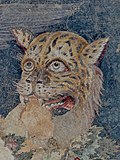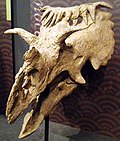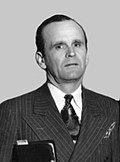| << | Today's featured articles for February 2020 | >> | ||||
|---|---|---|---|---|---|---|
| Su | Mo | Tu | We | Th | Fr | Sa |
| 1 | ||||||
| 2 | 3 | 4 | 5 | 6 | 7 | 8 |
| 9 | 10 | 11 | 12 | 13 | 14 | 15 |
| 16 | 17 | 18 | 19 | 20 | 21 | 22 |
| 23 | 24 | 25 | 26 | 27 | 28 | 29 |
February 1
Prince Romerson (c. 1840 – 1872) was a Native Hawaiian who fought in the American Civil War at a time when the Kingdom of Hawaii was an independent nation. Living in the American Northeast before the war, Romerson enlisted in the Union Navy in 1863 and served in the Atlantic Blockading Squadron. After being discharged, he reenlisted in the 5th Regiment Massachusetts Colored Volunteer Cavalry, a United States Colored Troops (USCT) regiment, in April 1864. Romerson rose to the rank of sergeant and was mustered out in October 1865, due to illness. After the war, like many USCT veterans, he remained in the army as a member of the Buffalo Soldiers (pictured), serving on the western frontier. In 2010, he was commemorated with over 100 other Native Hawaiian and Hawaiian-born "Hawaiʻi Sons of the Civil War" when a bronze plaque was erected along the memorial pathway at the National Memorial Cemetery of the Pacific in Honolulu. (Full article...)
February 2
The San Francisco–Oakland Bay Bridge half dollar is a fifty-cent piece struck by the United States Bureau of the Mint in 1936 as a commemorative coin. One of many commemoratives issued that year, it was designed by Jacques Schnier and honors the opening of the Bay Bridge that November. One side of the coin depicts a grizzly bear, a symbol of California, and the other shows the San Francisco–Oakland Bay Bridge, with the Ferry Building. Congress passed authorizing legislation for the coin in 1936. Schnier's models were approved and the coins were struck at the San Francisco Mint. Just over 70,000 coins were sold, by mail, in person, and from booths at the Bay Bridge's approaches, making it the first commemorative coin to be sold on a drive-in basis. The coins were taken off sale in February 1937, with the unsold remainder returned to the Mint for redemption and melting. The Bay Bridge half dollar catalogs in the low hundreds of dollars, depending on condition. (Full article...)
February 3
Ghost Stories was a U.S. pulp magazine that published 64 issues between 1926 and 1932. It was one of the earliest competitors to Weird Tales, the first magazine to specialize in the fantasy and occult fiction genre. Ghost Stories was a companion magazine to True Story and True Detective Stories, and focused almost entirely on stories about ghosts, many of which were written by staff writers but presented under pseudonyms as true confessions. These were often accompanied by faked photographs to make the stories appear more believable. Ghost Stories also ran original and reprinted contributions, including works by Robert E. Howard, Carl Jacobi, and Frank Belknap Long. Among the reprints were Agatha Christie's "The Last Seance" (under the title "The Woman Who Stole a Ghost"), several stories by H. G. Wells, and Charles Dickens's "The Signal-Man". The magazine was initially successful, but had begun to lose readers by 1930, and ceased publication at the start of 1932. (Full article...)
February 4
The Pacific swift (Apus pacificus) is a bird that breeds in eastern Asia. This swift is strongly migratory, spending the northern hemisphere's winter in a wide range of habitats in Southeast Asia and Australia. The general shape and blackish plumage recall its relative, the common swift, from which it is distinguished by a white rump band and heavily marked underparts. Its main call is a screech typical of its family. It breeds in sheltered locations such as caves and rock crevices, or under the eaves of houses. The nest is a half-cup of dry grass and other fine material that is gathered in flight, cemented with saliva and attached to a vertical surface. Two or three white eggs are incubated for about seventeen days before hatching. Like all swifts, the Pacific swift feeds exclusively on insects caught in flight. The species has a large population that occurs as far afield as the US and New Zealand, and rarely in Europe. (Full article...)
February 5

The mosaics of Delos are a significant body of ancient Greek mosaic art. Most of the surviving mosaics from Delos, Greece, an island in the Cyclades, date to the last half of the 2nd century BC and early 1st century BC, during the Hellenistic period and beginning of the Roman period. About half of all surviving tessellated mosaics from Hellenistic Greece come from Delos. The paved walkways of Delos range from simple pebble or chip-pavement constructions to elaborate mosaic floors composed of tesserae. Most motifs contain simple geometric patterns, while a handful utilize the opus tessellatum and opus vermiculatum techniques to create lucid, naturalistic, and richly colored scenes and figures. Mosaics have been found in places of worship, public buildings, and private homes. They share characteristics with those in other parts of the Greek world, such as Macedonian mosaics in Pella. They often employ a black-background technique as seen in the red-figure pottery of the Classical period. (Full article...)
February 6
SMS Zähringen was a pre-dreadnought battleship of the Wittelsbach class of the Imperial German Navy. She was laid down in November 1899 and completed October 1902. She and her sister ships—Wittelsbach, Wettin, Schwaben and Mecklenburg—were armed with a main battery of four 24 cm (9.4 in) guns and had a top speed of 18 knots (33 km/h; 21 mph). These and the other ships of I Squadron underwent extensive annual training, as well as making goodwill visits to foreign countries. Zähringen was decommissioned in September 1910 as dreadnought battleships began to enter service and she saw little activity until the start of World War I in 1914. Zähringen saw limited duty in the Baltic Sea and played a minor role in the Battle of the Gulf of Riga. The ship was withdrawn from active service in late 1915 due to crew shortages and the threat from British submarines. After the war, she was converted into a radio-controlled target ship. (Full article...)
February 7
William McSherry (1799–1839) was a Catholic priest, a prominent leader of the Jesuits in the United States, and a president of Georgetown College in Washington, D.C. Born in western Virginia, McSherry studied at Georgetown and was educated for the priesthood in Rome, where he discovered significant, forgotten holdings in the Jesuit archives about the early European settling of Maryland and the language of Native American tribes. McSherry served as the first provincial superior of the Jesuit Maryland Province from 1833 to 1837 and laid the groundwork for the sale of 272 of its slaves. He then became President of Georgetown College, exchanging positions with Thomas Mulledy, who executed the sale as provincial. Upon Mulledy's suspension in 1839 over the slave sale scandal, McSherry again became provincial. Near to death, his term lasted just several months. In 2015, due to his and Mulledy's involvement in the slave sale, Georgetown University renamed McSherry Hall. (Full article...)
February 8
Baden-Powell House is a Scouting hostel and conference centre in South Kensington, London. Built as a tribute to Lord Baden-Powell, the founder of Scouting, it is owned by The Scout Association. The house was designed in 1956 in the modern architectural style by Ralph Tubbs, whose works included the Dome of Discovery, the highlight of the 1951 Festival of Britain. Olave Baden-Powell laid the foundation stone in 1959, and the building was opened by Queen Elizabeth II in 1961. A granite statue of Baden-Powell, sculpted by Don Potter, was unveiled at the opening. The building has been refurbished several times, and now provides lodging for Scouts, Girl Guides and the general public. A collection of Baden-Powell memorabilia formerly displayed at the site, including several first editions of his books and many of his drawings and letters, has been moved to the headquarters for Scouting in the UK at Gilwell Park. (Full article...)
February 9
Adele Spitzeder (9 February 1832 – 27 or 28 October 1895) was a German actress, folk singer, and confidence trickster. Initially a promising young actress, Spitzeder became a private banker in Munich when her theatrical success dwindled. Running what was possibly the first recorded Ponzi scheme, she offered large returns on investments by continually using the money of new investors to pay back the previous ones. At the height of her success, contemporary sources considered her the wealthiest woman in Bavaria, although she maintained the persona of a pious Christian woman who helped the poor. Brought to trial in 1872, she was convicted of bad accounting and mishandling customers' money, since Ponzi schemes were not yet illegal, and sentenced to three years in prison. In her later years, Spitzeder performed as a folk singer, living off friends and benefactors, but never completely left her criminal life, resulting in further trials and periods of incarceration. (Full article...)
February 10
Abby is an American sitcom created by Nat Bernstein and Michael Katlin that aired for one season on UPN from January 6, 2003, to March 4, 2003. The show features Sydney Tamiia Poitier (pictured) as television producer Abby Walker and Kadeem Hardison as her ex-boyfriend Will Jeffries. After they break up in the pilot episode, they agree to live together as friends in their rent-controlled San Francisco apartment. Bernstein and Katlin had intended to feature an interracial couple, casting Sean O'Bryan as Will. After a negative response from test audiences, they gave the role to Hardison and recast O'Bryan as a supporting character, along with Randy J. Goodwin and Tangie Ambrose. Despite UPN's heavy promotion, the show attracted a weekly average of just 1.7 million viewers, making it the lowest-performing show tracked by Nielsen Holdings at the time. Critical responses were primarily negative; commentators praised Poitier's acting but criticized the show's reliance on sexual humor. (Full article...)
February 11
The Yeomanry Cavalry was the mounted component of the British Volunteer Corps, a military auxiliary established in the late 18th century. When the Volunteer Corps was disbanded after the defeat of Napoleon in 1815, the yeomanry – recruited from the middle and upper classes – was retained as a politically reliable institution that could act as a mounted police force. It became infamous after playing a leading part in the Peterloo Massacre of 1819, and its policing role declined as civilian police forces were established in the mid-19th century. The yeomanry struggled to find a place in the military establishment, and it survived largely because of its members' political influence and willingness to subsidise it financially. It found a new relevance when the Second Boer War revealed a need for mounted infantry. It was reorganised in 1901 as the Imperial Yeomanry, and in 1908 it ceased to be a discrete institution when all volunteer auxiliaries were amalgamated into the Territorial Force. (Full article...)
February 12
Arthur Sullivan (13 May 1842 – 22 November 1900) was an English composer best known for his operatic collaborations with the dramatist W. S. Gilbert. Among his early works were a ballet, a symphony, a cello concerto and a one-act comic opera, Cox and Box, which is still widely performed. He wrote his first opera with Gilbert, Thespis, in 1871. In 1875 the impresario Richard D'Oyly Carte engaged Gilbert and Sullivan to create a one-act piece, Trial by Jury. Its box-office success led the partners to collaborate on 12 full-length comic operas, including H.M.S. Pinafore, The Pirates of Penzance and The Mikado. Sullivan's only grand opera, Ivanhoe, though initially successful in 1891, has rarely been revived. His works include 24 operas, 11 major orchestral works, 10 choral works and oratorios, 2 ballets, incidental music to several plays, and numerous church pieces, songs, and piano and chamber pieces. His hymns and songs include "Onward, Christian Soldiers" and "The Lost Chord". (Full article...)
February 13
The Unconquered is a three-act play written by Russian-American author Ayn Rand as an adaptation of her 1936 novel We the Living. Producer George Abbott staged the play on Broadway in February 1940, featuring Helen Craig (pictured) as Kira Argounova, a young woman living in the Soviet Union in the 1920s. Her lover Leo Kovalensky develops tuberculosis. To get money for his treatment, Kira has an affair with a Communist official, Andrei Taganov. After Leo recovers from his illness, he becomes involved with black market food sales that Andrei is investigating. When Andrei realizes that Kira loves Leo, he helps his rival avoid prosecution, then commits suicide. Leo leaves Kira, who decides to risk her life escaping the country. The production was troubled by problems with the script and the cast. When the play opened at the Biltmore Theatre, it was a critical and financial failure, and closed in less than a week. It was the last of Rand's plays produced during her lifetime. (Full article...)
February 14
Love It to Death is the third studio album by the American rock band Alice Cooper (pictured), released in March 1971. The band took the name Alice Cooper in 1968 and became known for its outrageous theatrical live shows, but its first two albums failed to find an audience. In 1970 the band's single "I'm Eighteen" achieved top-forty success, peaking at No. 21 in the US and No. 7 in Canada. This convinced Warner Bros. that Alice Cooper had the commercial potential to release an album. Love It to Death reached No. 35 on the Billboard 200 albums chart and has since been certified platinum. In addition to "I'm Eighteen", a second track from the album, "Caught in a Dream", was released as a single and charted at No. 94 in the US. The album is seen as a foundational influence on hard rock, punk, and heavy metal. Several tracks have become live Alice Cooper standards and are frequently covered by other bands. (Full article...)
February 15
Roger B. Chaffee (February 15, 1935 – January 27, 1967) was an American naval aviator, aeronautical engineer, and astronaut in the Apollo program. He died in a fire along with Gus Grissom and Ed White during a pre-launch test for Apollo 1. Before joining NASA, Chaffee obtained his private pilot's license and graduated from Purdue University in 1957. Joining the U.S. Navy as an ensign, he trained to fly the T-34, T-28, and A3D. Serving as quality and safety control officer for Heavy Photographic Squadron 62, he took crucial photos of Cuba during the Cuban Missile Crisis, earning him the Air Medal. He joined NASA's Astronaut Group 3 in 1963 and served as capsule communicator at Mission Control Center in Houston for the Gemini 3 and Gemini 4 missions. He was given his first spaceflight assignment in 1966 as the third-ranking pilot on Apollo 1 and was promoted soon after to lieutenant commander in the Navy. He was posthumously awarded the Congressional Space Medal of Honor and a second Air Medal. (Full article...)
February 16
Marvel's Spider-Man is a 2018 action-adventure game developed by Insomniac Games for the PlayStation 4 console. In the main storyline, the crime lord Mister Negative threatens to release a deadly virus; Spider-Man, voiced by Yuri Lowenthal (pictured), must confront him and protect New York City. Shown in third-person perspective, the superhero can move freely around the city, interacting with characters, undertaking missions, and casting webs to incapacitate foes. Development began in 2014 and took approximately four years. Reviewers praised the game for its narrative, characterization, combat, and web-swinging traversal mechanics, although some criticized its open-world design for lacking innovation. Spider-Man became one of the best-selling PlayStation 4 games of all time, and the fastest-selling superhero game in the United States. It was followed by the downloadable, story-based Spider-Man: The City that Never Sleeps, which was released monthly from October to December 2018. (Full article...)
February 17
Tropical Storm Carlotta was a tropical cyclone that caused flooding in several states in southwestern and central Mexico. The system strengthened into a tropical storm on June 15, 2018. It reached peak intensity two days later with reported maximum sustained winds of 65 mph (100 km/h) and a minimum central pressure of 997 millibars (29.44 inHg) when it was only 30 mi (50 km) south-southeast of Acapulco. Interaction with the land and wind shear weakened the storm to a tropical depression later in the day, and on June 19 the storm dissipated. Carlotta prompted the issuance of watches and warnings for the southern coast of Mexico. The storm caused three deaths, two in Aguascalientes and the other in Oaxaca. Flooding and landslides also occurred throughout the states of Aguascalientes, Guerrero, Michoacán, Oaxaca, and Puebla, as well as in the Yucatán Peninsula. Damage from the system was reported to be minor. (Full article...)
February 18
Neferefre was a pharaoh of the Fifth Dynasty of ancient Egypt in the 25th century BC, during the Old Kingdom period. Known as prince Ranefer before he ascended the throne, he was probably the eldest son of pharaoh Neferirkare Kakai and queen Khentkaus II. Neferefre started a pyramid for himself in the royal necropolis of Abusir and was buried in it, although it was unfinished. The pyramid was roughly completed by his brother Nyuserre Ini, who succeeded him after the rule of Shepseskare. Fragments of Neferefre's mummy indicate that he died in his early twenties, after two years of reign. A single text shows that he had planned or just started to build a sun temple called Hotep-Re, meaning "Ra is content" or "Ra's offering table". Like other Fifth Dynasty kings, he benefited from a funerary cult, but the cult was abandoned by the late Old Kingdom. Because his pyramid and mortuary complex were unfinished, they may have attracted less attention from grave and stone robbers than nearby pyramids. (Full article...)
February 19
Kosmoceratops was a ceratopsid dinosaur that lived in what is now the U.S. state of Utah about 76.4–75.5 million years ago, during the Late Cretaceous. Specimens of the genus were discovered in Grand Staircase–Escalante National Monument in 2006 and 2007. It had an estimated length of 4.5 m (15 ft) and weight of 1.2 t (1.3 short tons). Kosmoceratops (from Greek for "ornate horned face") was named for its skull, the most ornamented of any known dinosaur, with fifteen well-developed horns and horn-like structures. It had a triangular beak with a pointed tip, a blade-like nasal horn, and two horns that pointed up and to the sides, then downwards. The neck frill was short from front to back, with eight hook-like processes on the hind margin curving forwards, and two curving to the sides. Kosmoceratops grew rapidly and, like modern birds and mammals, had an elevated metabolism. Its teeth were adapted to chewing fibrous plants. (Full article...)
February 20
An ashcan comic is a type of American comic book originally created solely to establish trademarks on potential titles and not intended for sale. It was developed by publishers including All-American Publications and Fawcett Comics to gain legal protection for desirable titles. An ashcan comic was the same size as a regular comic book and usually had a black and white cover. The practice became common in the 1930s and 1940s when the comic book industry was in its infancy, but was phased out after updates to US trademark law. The term "ashcan" was revived in the 1980s by Bob Burden, who applied it to prototypes of his self-published comic book. Since the 1990s, the term has been used to describe promotional materials produced in large print runs and made available for mass consumption. In the film and television industries, the term has been adopted for low-grade material created to preserve a claim to licensed property rights. (Full article...)
February 21
Wail al-Shehri (1973–2001) was one of five hijackers of American Airlines Flight 11, which was flown into the North Tower of the World Trade Center as part of the September 11 attacks. He and his younger brother Waleed joined an Al-Qaeda training camp in Afghanistan in March 2000. They were chosen, along with other Saudis, to participate in the attacks. Shehri returned to Saudi Arabia in October 2000 to obtain a clean passport and went back to Afghanistan before arriving in the United States in early June 2001. He stayed in motels in the Boynton Beach area of south Florida. On September 5, 2001, Shehri traveled to Boston and checked into a motel with his brother. Six days later, he arrived early in the morning at Boston's Logan International Airport and boarded American Airlines Flight 11. Shehri, his brother and three other hijackers deliberately crashed the airliner into the North Tower at 8:46 a.m. (Full article...)
February 22
Valley View is a mid-19th-century Greek Revival residence and farm overlooking the South Branch Potomac River northwest of Romney, West Virginia. Sitting atop a promontory where Depot Valley joins the South Branch Potomac River valley, the house was built by James Parsons Jr. in 1855. It is a two-story brick structure with a rectangular architectural plan. The front entrance is covered by a small portico, topped with a pediment supported by wooden Doric columns. The rear of the house, with a two-story wood porch stretching across it, faces Mill Creek Mountain. Each of the eight large rooms of the original structure contains a fireplace framed by a wooden trabeated mantelpiece with classical elements. The original windows, wooden trim, and materials in the main section of the house are intact. The house was listed on the National Register of Historic Places in 2012 as a locally significant example of Greek Revival architecture. (Full article...)
February 23
The rainbow pitta (Pitta iris) is a small passerine bird in the pitta family, Pittidae, endemic to northern Australia. The species is most closely related to the superb pitta of Manus Island. A colourful bird, it has a velvet black head with chestnut stripes above the eyes, olive green upper parts, black underparts, a bright red belly and an olive green tail. The rainbow pitta lives in the monsoon forests, as well as some drier eucalypt forests. As with other pittas, it is a secretive and shy bird. The diet consists mainly of insects, other arthropods and small vertebrates. Pairs defend territories and breed during the rainy season, as this time of year provides the most food for nestlings. The female lays three to four eggs with blotches inside its large domed nest. Both parents defend the nest, incubate the eggs and feed the chicks. The species is common within its range, and is not threatened. (Full article...)
February 24
Clare Stevenson (1903–1988) was the inaugural director of the Women's Auxiliary Australian Air Force (WAAAF), from May 1941 to March 1946. As such, she was described in 2001 as "the most significant woman in the history of the Air Force". Formed as a branch of the Royal Australian Air Force in March 1941, the WAAAF was the first and largest uniformed women's service in Australia during World War II. Born and educated in Victoria, Stevenson was an executive with the Berlei company when she was appointed Director WAAAF. Initially ranked squadron officer, she rose to become group officer by April 1942. Stevenson resumed her civilian career following her discharge from the Air Force in 1946. Long active in adult education and social welfare, she helped form aid organisations including the Carers Association of New South Wales (now Carers NSW) after retiring from Berlei in 1960. (Full article...)
February 25
The 2006 Bank of America 500 was the 31st stock car race of the 2006 NASCAR Nextel Cup Series and the fifth in the ten-race season-ending Chase for the Nextel Cup. It was held on October 14, 2006, before a crowd of 175,000 in Concord, North Carolina, at Lowe's Motor Speedway. The 334-lap race was won by Kasey Kahne (pictured) of the Evernham Motorsports team, who started from second position. Jimmie Johnson finished second and Jeff Burton was third. There were 10 cautions and 34 lead changes. The victory was Kahne's sixth of the season, and the seventh since his NASCAR debut in 2004. After the race Burton maintained his lead in the Drivers' Championship, which increased to 45 points over his nearest rival Matt Kenseth. Kahne's victory moved him from ninth to eighth, while Jeff Gordon dropped to tenth. Chevrolet maintained its lead in the Manufacturers' Championship with five races left in the season. (Full article...)
February 26
The Cabinet of Dr. Caligari is a German silent horror film, first released on 26 February 1920. It was directed by Robert Wiene and written by Hans Janowitz and Carl Mayer. Considered the quintessential work of German Expressionist cinema, it tells the story of an insane hypnotist (Werner Krauss) who uses a somnambulist (Conrad Veidt) to commit murders. The film features a dark and twisted visual style. The sets have sharp-pointed forms, oblique and curving lines, and structures that lean and twist in unusual angles. The film's design team, Hermann Warm, Walter Reimann and Walter Röhrig, recommended a fantastic, graphic style over a naturalistic one. With a violent and insane authority figure as its antagonist, the film expresses the theme of brutal and irrational authority. Considered a classic, it helped draw worldwide attention to the artistic merit of German cinema and had a major influence on American films, particularly in the genres of horror and film noir. (Full article...)
February 27
William M. Branham (1909–1965) was an American Christian minister and faith healer who initiated the healing revival movement after World War II and left a lasting impact on televangelism and the modern charismatic movement. After claiming to have received an angelic visitation on May 7, 1946, Branham launched his worldwide ministry and campaigning career in June. His inter-denominational meetings were the largest religious meetings that had ever been held in some American cities. Branham was the first American deliverance minister to successfully campaign in Europe. His ministry reached global audiences with major campaigns held in North America, Europe, Africa, and India. Crowds were drawn to his stories of angelic visitations and reports of miracles happening at his meetings. His ministry spawned many emulators and set in motion the broader healing revival that later became the modern Charismatic movement. (Full article...)
February 28
The 15th Tank Corps of the Soviet Union's Red Army fought in the Soviet invasion of Poland in 1939 during World War II, participating in the capture of Grodno and the Augustów Forest. The tank corps was re-formed in 1942 under Major General Vasily Koptsov as part of the 3rd Guards Tank Army (Soviet Guards insignia pictured) and saw combat in the Kozelsk Offensive, taking heavy losses in proportion to the territory gained. The corps was transferred to the southern front in the Ostrogozhsk–Rossosh Offensive during January 1943, where it helped encircle thousands of Axis troops around the river Don. In February 1943, the unit fought in Operation Star, capturing the key city of Kharkov in eastern Ukraine. After the Soviet advance outran its supply lines, the corps was worn down and virtually destroyed by a German counteroffensive in the Third Battle of Kharkov. It was later rebuilt as part of the 3rd Guards Tank Army and fought in Operation Kutuzov. (Full article...)
February 29
The Zoo TV Tour (29 February 1992 – 10 December 1993) was a concert tour by Irish rock band U2. Supporting their 1991 album Achtung Baby, the tour visited North America, Europe, Oceania, and Japan. In contrast to U2's previously austere stage setups, Zoo TV shows were elaborate multimedia events, satirising television and media oversaturation by attempting to instill sensory overload in the audience. The stages featured dozens of video screens as well as Trabants as lighting fixtures. Concerts included channel surfing, prank calls, a belly dancer, and transmissions from war-torn Sarajevo. On stage, Bono portrayed characters such as "The Fly" (pictured), "Mirror Ball Man", and "MacPhisto". Zoo TV was the highest-grossing North American tour of 1992 and sold 5.3 million tickets overall. Continuing their 1990s reinvention that began with Achtung Baby and Zoo TV, U2 recorded the album Zooropa during a break in the tour. Many critics gave the tour high praise as a memorable spectacle. (Full article...)



























